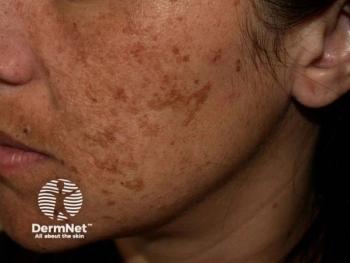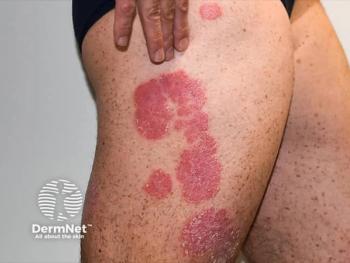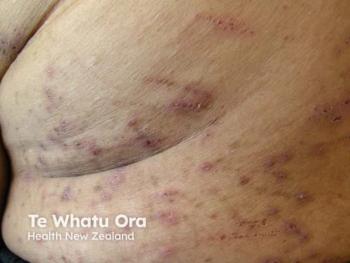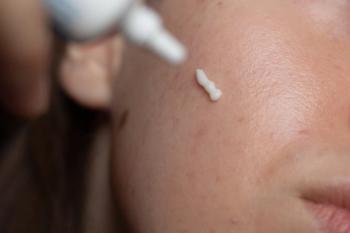
Can Colloidal Oat Emollients Be Used to Treat Pediatric Atopic Dermatitis?
Key Takeaways
- Colloidal oat emollients are effective, safe, and cost-efficient for pediatric atopic dermatitis, improving skin barrier function and reducing disease burden.
- Studies show significant reductions in Eczema Area and Severity Index (EASI) scores and decreased need for additional therapies with colloidal oat use.
Sophisticated colloidal oat emollients show promise in effectively managing pediatric atopic dermatitis, enhancing skin hydration and reducing flare-ups in infants.
Investigators have published a new literature review of clinical studies on colloidal oat-containing emollients for the treatment of pediatric atopic dermatitis (AD).1 Emollients with colloidal oat are commonly used to manage AD symptoms in adults, but little has been investigated about their use in pediatric disease. With this new evidence, researchers can suggest that these emollients can be effective, well-tolerated, and cost-efficient for pediatric patients with AD.
A comprehensive literature search was conducted on clinical and preclinical studies that evaluated the use of oat-derived ingredients in dermatology. The included trials focused on skin barrier function, disease prevention, immune modulation, health care utilization, and food allergy risk.
The literature confirmed that colloidal oat emollients are more effective compared to vehicle, thanks to their physicochemical properties. These emollients are also safe when applied to pediatric skin, as emphasized by randomized controlled trials. One study found that a 1% colloidal oat over-the-counter emollient was more effective than a ceramide-based steroid-free prescription skin barrier cream, even in a subgroup of Black patients. Any adverse effects were minor and included transient rash, itching, and eczema.
Colloidal oat products consistently had more significant reductions in Eczema Area and Severity Index (EASI) scores. Real-world data showed that colloidal oat emollients improved hydration, supported barrier repair, and reduced transepidermal water loss. This, in turn, led to fewer AD flares, lower health care costs, and fewer visits to the clinic. One sub-analysis found that patients who began colloidal oat emollient treatment soon after AD diagnosis had a lower risk of needing topical corticosteroids, antibiotics, or other steroidal therapies compared to those who never used the emollient treatment. All of these improvements can be associated with the reduction of disease burden for patients, families, and caregivers.
These formulations were also tested in infants from birth to prevent AD from ever occurring. Findings suggest that early and consistent use of these more sophisticated products may lower AD incidence and reduce food sensitization, especially in high-risk infants with a family history of AD. The STOP-AD study, for example, found that an emollient containing fatty acid and glycerin along with colloidal oat, reduced the emergence of AD in 1 year when used just in the first 2 months of life. Further safety studies demonstrated that there are no concerns about sensitization to oats and there is no increased food allergy risk when using these products. However, allergic reactions may still be possible in some patients.
pH-balanced emollient creams can support skin acidification and strengthen the barrier, especially in this vulnerable patient population. Colloidal oat forms an occlusive barrier, promoting moisture retention and stimulating the production of lactic acid.2 Even with these significant insights, there is still an unmet need for more effective emollient options in treating infant AD.3 Future studies should directly compare various formulations to determine which products are optimal for clinical AD management, especially in diverse populations. Additionally, comprehensive usage guidelines for families should be developed for both prevention and treatment.
“While colloidal oat satisfies many criteria for an effective emollient ingredient – hydration, barrier repair, microbiome modulation, and anti-inflammatory effects – successful formulation requires ingredient compatibility, stability, and delivery systems,” the authors wrote. “Balancing these factors ensures both efficacy and safety, making emollient formulation both a science and an art.”
Want to hear more pearls and insights on atopic dermatitis from the experts? Join us at the annual
References
1. Fowler JF, Ma L, Bergman J, et al. Is colloidal oat an effective emollient ingredient for the prevention and treatment of atopic dermatitis in infants?. J Dermatolog Treat. 2025;36(1):2487945. doi:10.1080/09546634.2025.2487945
2. Kurtz ES, Wallo W. Colloidal oatmeal: history, chemistry and clinical properties. J Drugs Dermatol. 2007;6(2):167-170.
3. Perrett KP, Peters RL. Emollients for prevention of atopic dermatitis in infancy. Lancet. 2020;395(10228):923-924. doi:10.1016/S0140-6736(19)33174-5
Newsletter
Like what you’re reading? Subscribe to Dermatology Times for weekly updates on therapies, innovations, and real-world practice tips.


















